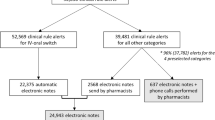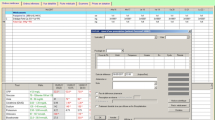Abstract
Background According to several studies, despite of the existence of several published guidelines for dosing adjustments based on renal function, inappropriate prescribing is a common drug-related problem in inpatient care. Objective We developed and implemented a system for drug dosage adjustment integrated into the Hospital computer provider order entry system. This system allows pharmacists to identify patients with reduced renal function, identify medication orders that may require dosage modifications based on renal function, and generate an alert with a recommendation of specific dosage adjustment. Using the Summary of Product Characteristics and two drug databases (Micromedex 2.0® and Lexicomp®), specific dosage guidelines for drugs used in patients with renal impairment were established. Setting A 264-bed tertiary teaching hospital. Methods We performed a quasi-experimental, one-group, pretest–posttest study to assess the efficacy of this intervention program. We compared the differences between the frequency of appropriate orders pre- and post-test using the McNemar test. Main outcome measures: the frequency of appropriate orders before the recommendation (pre-test) and after the recommendation (post-test). Results Before the intervention, the frequency of appropriate prescribing based on renal function was 65 %. After the intervention, this frequency was 86 % (p < 0.001). The interventions were more frequent in the emergency department (45 %). The program required 30–45 min of pharmacist time per day. The average number of patients reviewed daily was 28. This study found that a computer-based, semi-automated drug-dosage program for renal failure patients was able to reduce the number of inappropriate orders due to renal insufficiency.



Similar content being viewed by others
References
Gracia S, Montanes R, Bover J, Cases A, Deulofeu R, Martin de Francisco AL, et al. Documento de consenso: Recomendaciones sobre la utilización de ecuaciones para la estimación del filtrado glomerular en adultos. Nefrologia. 2006;26(6):658–65.
Martinez Castelao A, Martin de Francisco A, Gorriz J, Alcazar R, Orte L. Estrategias en salud renal: un proyecto de la Sociedad Española de Nefrología. Nefrologia. 2009;29(3):185–92.
National Kidney F. K/DOQI clinical practice guidelines for chronic kidney disease: evaluation, classification, and stratification. Am J Kidney Dis. 2002;39(2 Suppl 1):S1–266.
Cockcroft DW, Gault MH. Prediction of creatinine clearance from serum creatinine. Nephron. 1976;16(1):31–41.
Levey AS, Bosch JP, Lewis JB, Greene T, Rogers N, Roth D. A more accurate method to estimate glomerular filtration rate from serum creatinine: a new prediction equation. Modification of Diet in Renal Disease Study Group. Ann Intern Med. 1999;130(6):461–70.
Alcazar R, Egocheaga MI, Orte L, Lobos JM, Gonzalez Parra E, Alvarez Guisasola F, et al. Documento de consenso SEN-semFYC sobre la enfermedad renal crónica. Nefrologia. 2008;28(3):273–82.
Munar MY, Singh H. Drug dosing adjustments in patients with chronic kidney disease. Am Fam Physician. 2007;75(10):1487–96.
Long CL, Raebel MA, Price DW, Magid DJ. Compliance with dosing guidelines in patients with chronic kidney disease. Ann Pharmacother. 2004;38(5):853–8.
Kuperman GJ, Bobb A, Payne TH, Avery AJ, Gandhi TK, Burns G, et al. Medication-related clinical decision support in computerized provider order entry systems: a review. J Am Med Inform Assoc. 2007;14(1):29–40.
Rubio Fernandez M, Aldaz Frances R, Garcia Gomez C, Valladolid Walsh A. Características de la prescripción electrónica asistida en hospitales españoles. Farm Hosp. 2005;29(4):236–40.
Sellier E, Colombet I, Sabatier B, Breton G, Nies J, Zapletal E, et al. Effect of alerts for drug dosage adjustment in inpatients with renal insufficiency. J Am Med Inform Assoc. 2009;16(2):203–10.
Alvarez Arroyo L, Climent Grana E, Bosacoma Ros N, Roca Merono S, Perdiguero Gil M, Ordovas Baines JP, et al. Evaluación de un programa de intervención farmacéutica en pacientes con medicamentos en riesgo renal. Farm Hosp. 2009;33(3):147–54.
Oppenheim MI, Vidal C, Velasco FT, Boyer AG, Cooper MR, Hayes JG et al. Impact of a computerized alert during physician order entry on medication dosing in patients with renal impairment. Proc AMIA Symp. 2002:577–81.
Bertsche T, Fleischer M, Pfaff J, Encke J, Czock D, Haefeli WE. Pro-active provision of drug information as a technique to address overdosing in intensive-care patients with renal insufficiency. Eur J Clin Pharmacol. 2009;65(8):823–9.
Falconnier AD, Haefeli WE, Schoenenberger RA, Surber C, Martin-Facklam M. Drug dosage in patients with renal failure optimized by immediate concurrent feedback. J Gen Intern Med. 2001;16(6):369–75.
Chertow GM, Lee J, Kuperman GJ, Burdick E, Horsky J, Seger DL, et al. Guided medication dosing for inpatients with renal insufficiency. JAMA. 2001;286(22):2839–44.
Peterson JP, Colucci VJ, Schiff SE. Using serum creatinine concentrations to screen for inappropriate dosage of renally eliminated drugs. Am J Hosp Pharm. 1991;48(9):1962–4.
Gea Rodriguez E, Barral Vinals N, Manso Mardones P, Indo Berges O. Contribución a la seguirdad en la utilización de heparina de bajo peso molecular en pacientes con insuficiencia renal. Farm Hosp. 2004;28(2):101–5.
Goldberg DE, Baardsgaard G, Johnson MT, Jolowsky CM, Shepherd M, Peterson CD. Computer-based program for identifying medication orders requiring dosage modification based on renal function. Am J Hosp Pharm. 1991;48(9):1965–9.
McMullin ST, Reichley RM, Kahn MG, Dunagan WC, Bailey TC. Automated system for identifying potential dosage problems at a large university hospital. Am J Health Syst Pharm. 1997;54(5):545–9.
Nightingale PG, Adu D, Richards NT, Peters M. Implementation of rules based computerised bedside prescribing and administration: intervention study. BMJ. 2000;320(7237):750–3.
Galanter WL, Didomenico RJ, Polikaitis A. A trial of automated decision support alerts for contraindicated medications using computerized physician order entry. J Am Med Inform Assoc. 2005;12(3):269–74.
Field TS, Rochon P, Lee M, Gavendo L, Baril JL, Gurwitz JH. Computerized clinical decision support during medication ordering for long-term care residents with renal insufficiency. J Am Med Inform Assoc. 2009;16(4):480–5.
Matsumura Y, Yamaguchi T, Hasegawa H, Yoshihara K, Zhang Q, Mineno T, et al. Alert system for inappropriate prescriptions relating to patients’ clinical condition. Methods Inf Med. 2009;48(6):566–73.
Rind DM, Safran C, Phillips RS, Wang Q, Calkins DR, Delbanco TL, et al. Effect of computer-based alerts on the treatment and outcomes of hospitalized patients. Arch Intern Med. 1994;154(13):1511–7.
Montanes-Pauls B, Saez-Lleo C, Martinez-Romero G. Ajuste de dosificación de medicamentos en pacientes ancianos institucionalizados con insuficiencia renal. Farm Hosp. 2009;33(1):43–7.
Wargo KA, Eiland EH 3rd, Hamm W, English TM, Phillippe HM. Comparison of the modification of diet in renal disease and Cockcroft-Gault equations for antimicrobial dosage adjustments. Ann Pharmacother. 2006;40(7–8):1248–53.
Stevens LA, Nolin TD, Richardson MM, Feldman HI, Lewis JB, Rodby R, et al. Comparison of drug dosing recommendations based on measured GFR and kidney function estimating equations. Chronic Kidney Disease Epidemiology Collaboration. Am J Kidney Dis. 2009;54(1):33–42.
The National Kidney Disease Educational Program. CKD and drug dosing: information for providers. [Internet] 2009 Sep [updated 2012 March; cited 2013 July 4]. Available from http://www.nkdep.nih.gov/resources/CKD-drug-dosing.shtml.
Acknowledgments
We thank Federico Tutau PharmD PhD, for his help in the initial design of the system. We also thank the hospital informatics department for its contribution to the design and implementation of the program.
Funding
This study was supported in part by the research grant ‘Salud, Prevención y Medio Ambiente y Seguros’, from Fundación MAPFRE.
Conflicts of interest
None.
Author information
Authors and Affiliations
Corresponding author
Rights and permissions
About this article
Cite this article
Such Díaz, A., Saez de la Fuente, J., Esteva, L. et al. Drug prescribing in patients with renal impairment optimized by a computer-based, semi-automated system. Int J Clin Pharm 35, 1170–1177 (2013). https://doi.org/10.1007/s11096-013-9843-3
Received:
Accepted:
Published:
Issue Date:
DOI: https://doi.org/10.1007/s11096-013-9843-3




